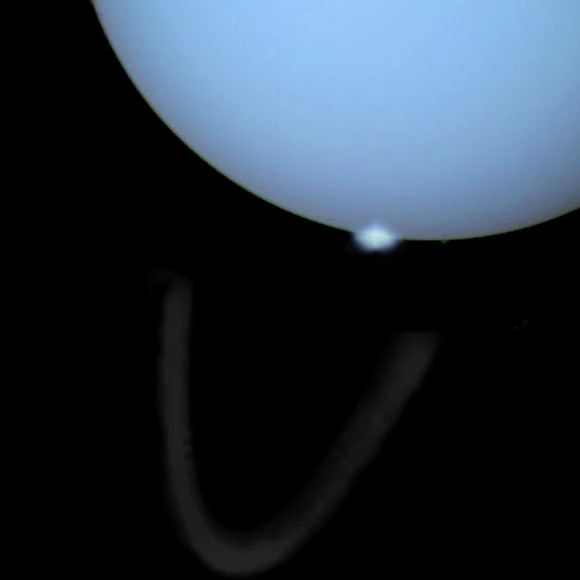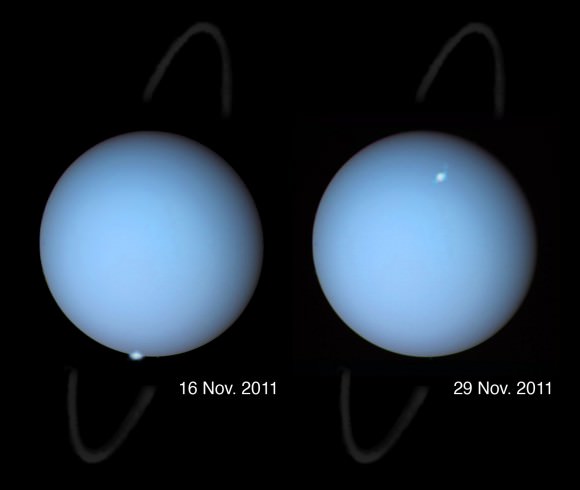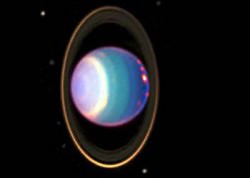Astronomers have finally succeeded in capturing the first Earth-based images of the curious and fleeting auroras of Uranus using the Hubble Space Telescope, careful planning… and no small amount of luck.
Unlike Earthly auroras, whose long-lived curtains of glowing green, red and purple have been the subject of countless stunning photos over the past months, Uranus’ auroras are relatively dim and short-lived, lasting only several minutes at most. They were first witnessed on Uranus by Voyager 2 in 1986, but never by any Earth-based telescopes until November of 2011. Using Hubble, an international team of astronomers led by Laurent Lamy from the Observatoire de Paris in Meudon, France spotted two instances of auroras on the distant planet… once on November 16 and again on the 29th.
Auroras are known to be created by a planet’s magnetosphere, which on Earth is aligned closely with the rotational axis — which is why auroras are seen nearest the polar latitudes. But Uranus’ magnetic field is quite offset from its rotational axis, which in turn is tipped nearly 98 degrees relative to its orbital path. In other words, Uranus travels around the Sun rolling on its side! And with a 60-degree difference between its magnetic and rotational axis, nothing on Uranus seems to point quite where it should. This — along with its 2.5-billion-mile (4 billion km) distance – makes for a “very poorly known” magnetic field.
“This planet was only investigated in detail once, during the Voyager flyby, dating from 1986. Since then, we’ve had no opportunities to get new observations of this very unusual magnetosphere,” said Laurent Lamy, lead author of the team’s paper Earth-based detection of Uranus’ aurorae.
Rather than rings of bright emissions, as witnessed on Earth as well as Saturn and Jupiter, the Uranian auroras appeared as bright spots of activity on the planet’s daytime side — most likely a result of Uranus’ peculiar orientation, as well as its seasonal alignment.
It’s not yet known what may be happening on Uranus’ night side, which is out of view of Hubble.
When Voyager 2 passed by Uranus in 1986 the planet was tipped such that its rotational axis was aimed toward the Sun. This meant that its magnetic axis — offset by 60 degrees — was angled enough to encounter the solar wind in much the same way that Earth’s does. This created the nightside auroras similar to Earth’s that Voyager saw.
By 2011, however, Uranus — which has an 84-year-long orbit — was near equinox and as a result its magnetic axis was nearly perpendicular with its orbital plane, aiming each end directly into the solar wind once a day. This makes for very different kinds of auroras than what was seen by Voyager; in fact, there’s really nothing else like it that astronomers know of.
“This configuration is unique in the solar system,” said Lamy.
Further investigations of Uranus’ auroras and magnetic field can offer insight into the dynamics of Earth’s own magnetosphere and how it interacts with the solar wind, which in turn affects our increasingly technological society.
The team’s paper will be published Saturday in Geophysical Research Letters, a journal of the American Geophysical Union.
Source: Universe Today



No hay comentarios:
Publicar un comentario